![]()
Manufacturer: ![]()
Year: 1989
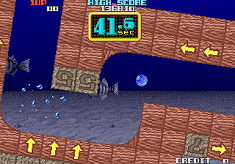 |
Camel Try is one of the most original and innovative Taito videogames ever
produced. We aren't in control of some space craft, we won't fight any supernatural monsters, we're not wearing the clothes
of a new hero, we won't do anything we've already done in the past! We have to move a coloured sphere within a barely-mazy
labyrinth and take it to the goal line within a certain amount of time - or game will be over. |
|
The control methods is another issue which adds innovations: we won't drive the sphere in a
Marble Madness style, but we'll have to rotate the background, while the sphere stands there in the center of the screen,
giving us the idea of it falling in empty space - until striking some obstacles. |
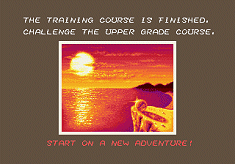 |
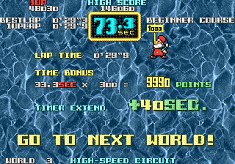 |
While playing, we'll find a few obstacles such as yellow and red bricks having an "X" inside. By hittign them with the sphere, a few seconds (2 and 5) will be subtracted from the available time. Other blocks would be just hit and destroyed if the sphere has enough speed. In this case we will get a 1000 points bonus score. We can increase the speed of the sphere by pressing and holding the "fire" button. Sphere can even jump by hitting and releasing the button - this can be very useful when the sphere is entraped in some parts of the labyrinth or when it's about to hit a red or yellow brick. |
|
There are a few useful bricks: the ones marked "E+" present us with 3 or 5 bonus
seconds; the ones marked "E-" do the exact contrary; there are the "?" bricks, which bring random
effects such as stopping time, add bonus time or 1000 extra points - or eventually just show a simple "Sorry, no
bonus" message! Other obstacles are undestructible, and we'll just have to make our sphere encircle them. |
 |
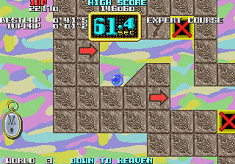 |
Even making the sphere rolling is worth something: 10 points per each "step"
done. |
|
When we clear all the worlds of the current level, game ends and we get an invitation
message to try the next difficulty level and showing a funny ending screen. |
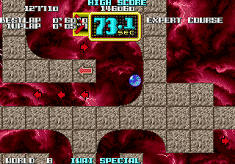 |
|
The Bonze's comment |
Ratings
PRESENTATION: 84%
One of the most complete I've
ever seen.
GRAPHICS: 91%
Well refined and great scrolling
for background.
SOUND: 65%
It does all it should do, though
doesn't reach highest levels
in quality.
ORIGINALITY: 99%
One of the most innovative videogames ever.
HOOKABILITY: 93%
Immediately playable, thanks
to the ease of gameplay.
LASTABILITY: 85%
Four difficulty levels and many worlds to complete in an
hooking race against time.
Innovations, ease and great playability make this one of the
best Taito videogames ever. An
absolute must-try... or better say
an absolute "Camel Try"!

 The control method is the first thing you'll
notice in this videogame. At first it reminded me of the rally game from Visco, Drift Out, in which players rotate
the circuit instead of the car itself - it yet let me impressed due to its originality. Well there are more differences actually:
the ball can't be controlled fully because of the gravity effect.
The control method is the first thing you'll
notice in this videogame. At first it reminded me of the rally game from Visco, Drift Out, in which players rotate
the circuit instead of the car itself - it yet let me impressed due to its originality. Well there are more differences actually:
the ball can't be controlled fully because of the gravity effect.
As soon as you get confident with the game, you start having fun with it, and difficulty is very well-balanced: easy levels
entertain the player and make him play more and more; in further levels difficulty and obstacles increase, though never making
levels "impossible" to complete.
A nice presentation explains everyting much clearly. Camel Try is a simple and much funny game in my opinion - you'll enjoy
it even if you hate puzzle-games in general.
 At last we have it: a really innovative
videogame, easy to understand, immediately playable, hooking and with a great presentation: one of the best ever produced by our
beloved Japanese company.
At last we have it: a really innovative
videogame, easy to understand, immediately playable, hooking and with a great presentation: one of the best ever produced by our
beloved Japanese company.
Graphics is well refined, nice backgrounds and pretty animations. Sounds are cool too, and they do what they should - though being
the weakest part of this videogame. not much to say about Camel Try: you just have to play it! Four difficulty levels make
this game attractive for anyone - so at last a different game to any other, which will satisfy the needs of everybody!
 Here we can see the way a fantastic
videogame can be created even with such few ideas! Something totally new is about to enter your life. Playability is at the top
(even though the original had a paddle controller), and learning it's very easy - presentation is quite unuseful and it's the
worst part of the game as usual, but the tutorial is very well done and it shows everything you should know in a few minutes.
Beside of the tutorial there are many more choices both for difficulty and stage. Let's talk about graphics: they're a great part
of the game, and colurful backgrounds don't cause any problem to the player's sight... Music tunes are OK (they remind me of the
golden oldie California Games...), but sound effects let me unsatisfied and at first they sound awful. You should become
confident with them or you'll go mad soon (kidding)!
Here we can see the way a fantastic
videogame can be created even with such few ideas! Something totally new is about to enter your life. Playability is at the top
(even though the original had a paddle controller), and learning it's very easy - presentation is quite unuseful and it's the
worst part of the game as usual, but the tutorial is very well done and it shows everything you should know in a few minutes.
Beside of the tutorial there are many more choices both for difficulty and stage. Let's talk about graphics: they're a great part
of the game, and colurful backgrounds don't cause any problem to the player's sight... Music tunes are OK (they remind me of the
golden oldie California Games...), but sound effects let me unsatisfied and at first they sound awful. You should become
confident with them or you'll go mad soon (kidding)!
I strongly suggest you to play it: you won't repent of it!
 Asoften at that time,
Taito innovated with this really cool game, and as far as I know, the concept as NEVER been copied (please correct
me if I'm wrong)...
Asoften at that time,
Taito innovated with this really cool game, and as far as I know, the concept as NEVER been copied (please correct
me if I'm wrong)...
